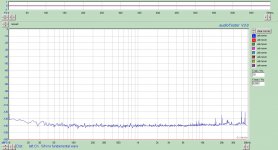Hi Guys,
I finally found some time to dig a little deeper into the DCX input and output stages to investigate exactly what was responsible for the lackluster performance shown in the preceding measurements.
This was definitely an interesting experiment, and I've got some great measurements to report back with!
So where to start? Well, I wanted to start with something simple and non-destructive, so I figured pulling the AES/EBU transformer out and wiring the digital input directly would be a good start. I had a hunch that some of the noise on the output was coupling in from the AES signals which share a common ribbon cable with the outputs.
I pulled out the transformer, wired it directly to an XLR connector, and wired that straight to the input of the ASRC. That allowed me to maintain the existing galvanic isolation but with a dedicated shielded cable. The old connections on the ribbon cable were left disconnected.
The results? Nada... no improvement at all. Noise remained higher with the digital input and looked pretty much identical to what it was before the modification, so no dice!
Next up, I wanted to isolate just the output stage and see what the noise and distortion looked like on the output stage all by itself. I disconnected the ribbon cable and wired the AP up to just the DCX output stage. I was a little surprised to see a very low noise floor, with absolutely none of the hash seen when it's being fed by the output of the DAC in the DCX. Noise floor was below -140dBV from 20Hz to 20kHz! That tells us that the output stage and the +/-15V supplies are not the ones responsible for our noisy output!
Measurement 1: Noise floor of output with ribbon disconnected
Measurement 2: FFT of output stage driven by AP - 2VRMS output 1kHz
What the output stage is responsible for, though, is the crummy distortion performance. The second harmonic is 114dB down which is reasonable, but the third, fifth and seventh harmonics are quite high at -89, -99 and -108 respectively. I'm not sure if the op-amps are to blame, or the filter design, but it's not an output stage that I would want in my signal path.
Lastly, let's take a look at the output of the DAC itself taken directly off the connector for the ribbon cable. I unplugged the output board completely (power and signal), and used my directly wired AES/EBU for input while measuring directly off the pins of the output connector.
That's more like it! Total differential output at -1dBFS is 1.5VRMS and distortion performance is improved significantly. The second harmonic is pretty much the same, but the third harmonic is down at -116dB, some 27dB better than with the output stage! All higher order harmonics are also significantly reduced.
What is still there, though, is that noise. The noise floor itself is acceptably low, but there's a big pile of hash all throughout the audio band which is still quite poor, although much better than it would have been amplified by the output stage!
Measurement 3: DAC Direct Output - FFT 1kHz @ 96kHz sample rate.
Measurement 4: DAC Direct Output - FFT 1kHz @ 44.1kHz sample rate - full band.
Measurement 5: DAC Direct Output - THD 1kHz @ 96kHz sample rate.
Measurement 6: DAC Direct Output - THD+N 1kHz @ 96kHz sample rate.
Measurement 7: DAC Direct Output - Distortion Product Ratio 1kHz @ 96kHz sample rate.
Measurement 8: DAC Direct Output - THD Vs FREQ @ 96kHz sample rate.
Based on the above, it seems like the general practice of bypassing the output stage and running direct from the DAC output has some solid merit. It brings output levels down to a more reasonable 1.5VRMS, reduces the overall output noise, and dramatically lowers distortion.
It's still not great though, and there are only really two things left it could be:
1. The ASRC on the digital input
2. The power supplies for +5VA and +5VD
From what I'm seeing, the supply indeed isn't as bad as I had initially thought, and based on the massive amounts of noise centered around the fundamental, I'm going to guess it's the ASRC and a whole pile of jitter.
In my next post, I'm going to formulate a few ideas for addressing the ASRC, as well as a plan for the outputs and inputs.
Cheers,
Owen
I finally found some time to dig a little deeper into the DCX input and output stages to investigate exactly what was responsible for the lackluster performance shown in the preceding measurements.
This was definitely an interesting experiment, and I've got some great measurements to report back with!
So where to start? Well, I wanted to start with something simple and non-destructive, so I figured pulling the AES/EBU transformer out and wiring the digital input directly would be a good start. I had a hunch that some of the noise on the output was coupling in from the AES signals which share a common ribbon cable with the outputs.
I pulled out the transformer, wired it directly to an XLR connector, and wired that straight to the input of the ASRC. That allowed me to maintain the existing galvanic isolation but with a dedicated shielded cable. The old connections on the ribbon cable were left disconnected.
The results? Nada... no improvement at all. Noise remained higher with the digital input and looked pretty much identical to what it was before the modification, so no dice!
Next up, I wanted to isolate just the output stage and see what the noise and distortion looked like on the output stage all by itself. I disconnected the ribbon cable and wired the AP up to just the DCX output stage. I was a little surprised to see a very low noise floor, with absolutely none of the hash seen when it's being fed by the output of the DAC in the DCX. Noise floor was below -140dBV from 20Hz to 20kHz! That tells us that the output stage and the +/-15V supplies are not the ones responsible for our noisy output!
Measurement 1: Noise floor of output with ribbon disconnected
Measurement 2: FFT of output stage driven by AP - 2VRMS output 1kHz
What the output stage is responsible for, though, is the crummy distortion performance. The second harmonic is 114dB down which is reasonable, but the third, fifth and seventh harmonics are quite high at -89, -99 and -108 respectively. I'm not sure if the op-amps are to blame, or the filter design, but it's not an output stage that I would want in my signal path.
Lastly, let's take a look at the output of the DAC itself taken directly off the connector for the ribbon cable. I unplugged the output board completely (power and signal), and used my directly wired AES/EBU for input while measuring directly off the pins of the output connector.
That's more like it! Total differential output at -1dBFS is 1.5VRMS and distortion performance is improved significantly. The second harmonic is pretty much the same, but the third harmonic is down at -116dB, some 27dB better than with the output stage! All higher order harmonics are also significantly reduced.
What is still there, though, is that noise. The noise floor itself is acceptably low, but there's a big pile of hash all throughout the audio band which is still quite poor, although much better than it would have been amplified by the output stage!
Measurement 3: DAC Direct Output - FFT 1kHz @ 96kHz sample rate.
Measurement 4: DAC Direct Output - FFT 1kHz @ 44.1kHz sample rate - full band.
Measurement 5: DAC Direct Output - THD 1kHz @ 96kHz sample rate.
Measurement 6: DAC Direct Output - THD+N 1kHz @ 96kHz sample rate.
Measurement 7: DAC Direct Output - Distortion Product Ratio 1kHz @ 96kHz sample rate.
Measurement 8: DAC Direct Output - THD Vs FREQ @ 96kHz sample rate.
Based on the above, it seems like the general practice of bypassing the output stage and running direct from the DAC output has some solid merit. It brings output levels down to a more reasonable 1.5VRMS, reduces the overall output noise, and dramatically lowers distortion.
It's still not great though, and there are only really two things left it could be:
1. The ASRC on the digital input
2. The power supplies for +5VA and +5VD
From what I'm seeing, the supply indeed isn't as bad as I had initially thought, and based on the massive amounts of noise centered around the fundamental, I'm going to guess it's the ASRC and a whole pile of jitter.
In my next post, I'm going to formulate a few ideas for addressing the ASRC, as well as a plan for the outputs and inputs.
Cheers,
Owen
Attachments
-
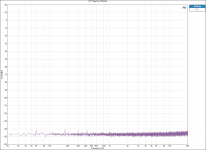 Analog Output Only Noise Floor.png90.5 KB · Views: 747
Analog Output Only Noise Floor.png90.5 KB · Views: 747 -
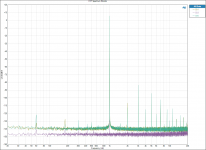 Analog Output Stage Only.png123.1 KB · Views: 732
Analog Output Stage Only.png123.1 KB · Views: 732 -
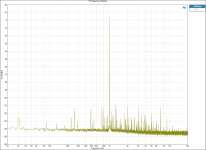 FFT Spectrum Monitor - DAC DIRECT -1dBFS.png100.8 KB · Views: 727
FFT Spectrum Monitor - DAC DIRECT -1dBFS.png100.8 KB · Views: 727 -
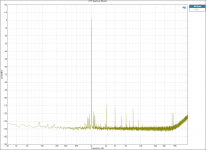 FFT Spectrum Monitor - DAC DIRECT -1dBFS 441k.png111 KB · Views: 714
FFT Spectrum Monitor - DAC DIRECT -1dBFS 441k.png111 KB · Views: 714 -
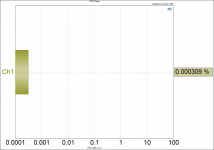 THD PCT - DAC DIRECT -1dBFS.png64.5 KB · Views: 153
THD PCT - DAC DIRECT -1dBFS.png64.5 KB · Views: 153 -
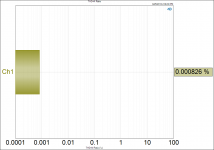 THD+N PCT - DAC DIRECT -1dBFS.png64.3 KB · Views: 142
THD+N PCT - DAC DIRECT -1dBFS.png64.3 KB · Views: 142 -
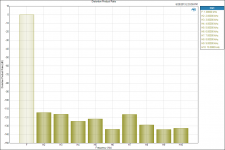 DPR - DAC DIRECT -1dBFS.png49.1 KB · Views: 137
DPR - DAC DIRECT -1dBFS.png49.1 KB · Views: 137 -
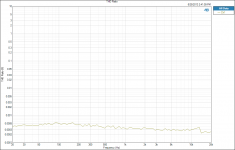 THD - DAC DIRECT -1dBFS vs freq.png64.1 KB · Views: 153
THD - DAC DIRECT -1dBFS vs freq.png64.1 KB · Views: 153
I finally found some time to dig a little deeper into the DCX input and output stages to investigate exactly what was responsible for the lackluster performance shown in the preceding measurements.
Excellent work, Owen - many thanks!
Definitely beats blindly trying random pieces of audiophile folklore...
yeah youve gotta love that dissection, i'm not interested in the box and certainly not after its mostly a hulking shell, but its hard to ignore the audio precision, of... the ... Audio Precision System ... With a competent operator its impressive how it can make for not light work, because i'm sure those tests took quite some effort, but certainly time well spent. It really puts a finger on the root causes and illuminates them in a way they can be eliminated, or the issues weighed up in order of importance to a specific user.
Kudos Owen, i'm sure there are many grateful people that will find this thread over the next years.
Kudos Owen, i'm sure there are many grateful people that will find this thread over the next years.
Last edited:
Hi Guys,
I finally found some time to dig a little deeper into the DCX input and output stages to investigate exactly what was responsible for the lackluster performance shown in the preceding measurements.
Next up, I wanted to isolate just the output stage and see what the noise and distortion looked like on the output stage all by itself. I disconnected the ribbon cable and wired the AP up to just the DCX output stage. I was a little surprised to see a very low noise floor, with absolutely none of the hash seen when it's being fed by the output of the DAC in the DCX. Noise floor was below -140dBV from 20Hz to 20kHz! That tells us that the output stage and the +/-15V supplies are not the ones responsible for our noisy output!
Measurement 1: Noise floor of output with ribbon disconnected
Measurement 2: FFT of output stage driven by AP - 2VRMS output 1kHz
What the output stage is responsible for, though, is the crummy distortion performance. The second harmonic is 114dB down which is reasonable, but the third, fifth and seventh harmonics are quite high at -89, -99 and -108 respectively. I'm not sure if the op-amps are to blame, or the filter design, but it's not an output stage that I would want in my signal path.
In my next post, I'm going to formulate a few ideas for addressing the ASRC, as well as a plan for the outputs and inputs.
Cheers,
Owen
If it hasnt been mentioned earlier... the output opamps are 4580 dual opamps.
Thx-RNmarsh
Last edited:
Any chance to add volume control ?
I think it would be great to connect DCX directly to amps.
Thanks
Yes.
DCX2496 6-channel vol control
jan
Jan, I was referring to opc upgrade kit, hoping that his ''kit'' will have volume control too 
I know about linearaudio project, but it was little out of my pocket
Hoping that opc upgrade ''kit'' will be some more affordable..will see what it will offer...
but I like idea, and wil follow this tread...
I also nead some digital input, as I dont have AES/EBU, so usb will be nice..(as opc mention)
I know about linearaudio project, but it was little out of my pocket
Hoping that opc upgrade ''kit'' will be some more affordable..will see what it will offer...
but I like idea, and wil follow this tread...
I also nead some digital input, as I dont have AES/EBU, so usb will be nice..(as opc mention)
Hi
I own 4 DCX2496, 2 with active outputs, one from Jan Didden(NL) and one from Selectronic (FR) and 2 with passive outputs, one of them i build in a 6 channel preamp/volumecontrol based on 3 PGA2311 (very cheap 5.1 ebay Chinese) and surprisingly for me that is the best one, I use a upgraded digital in, and the results are VERY good, no measurements, just my ears telling me all is fine!
if you want a pic, tell me..
tojoko
I own 4 DCX2496, 2 with active outputs, one from Jan Didden(NL) and one from Selectronic (FR) and 2 with passive outputs, one of them i build in a 6 channel preamp/volumecontrol based on 3 PGA2311 (very cheap 5.1 ebay Chinese) and surprisingly for me that is the best one, I use a upgraded digital in, and the results are VERY good, no measurements, just my ears telling me all is fine!
if you want a pic, tell me..
tojoko
if you want a pic, tell me..
We always like to see pictures, don't we?
Based on the above, it seems like the general practice of bypassing the output stage and running direct from the DAC output has some solid merit. It brings output levels down to a more reasonable 1.5VRMS, reduces the overall output noise, and dramatically lowers distortion.
Question from the newbie: would bypassing the output stage mean literally just running a few balanced mic cables from the main board to the XLR outputs?
Still thinking of getting one of these, and it looks like just bypassing the output board yields a lot of improvement.
TIA
Chris
- Status
- This old topic is closed. If you want to reopen this topic, contact a moderator using the "Report Post" button.
- Home
- Source & Line
- Digital Line Level
- DCX2496 Upgrade Board - Objectively Tackling the Improvement of a Stock DCX2496
